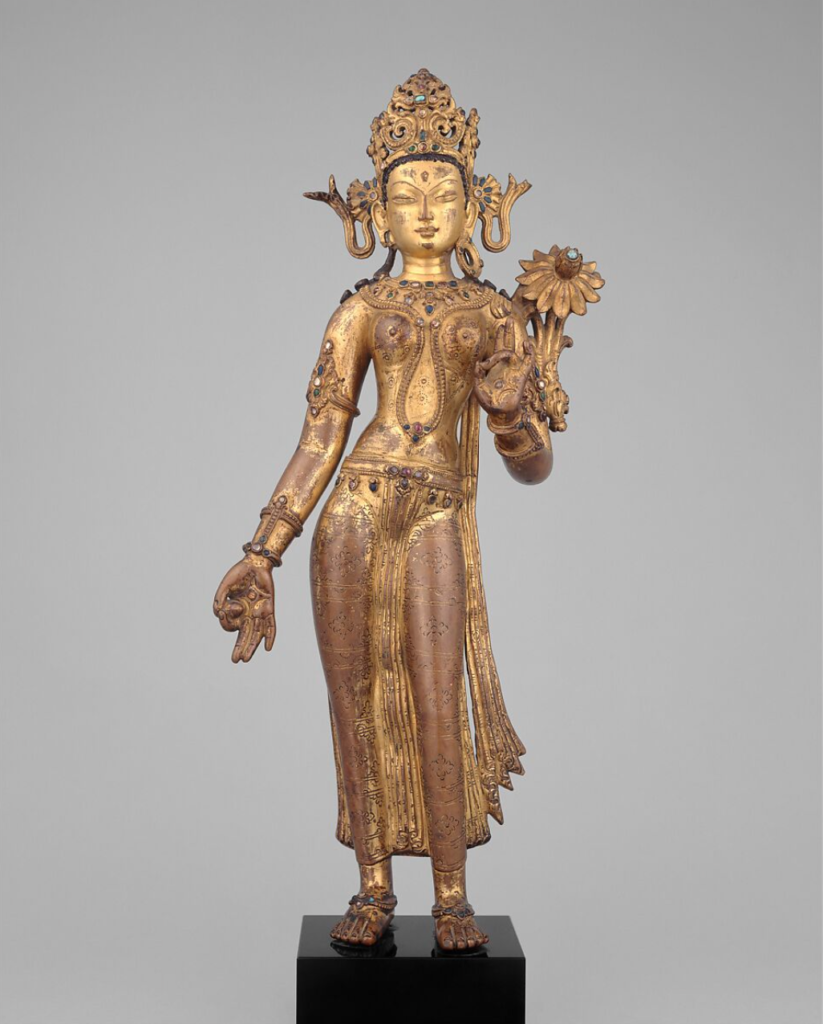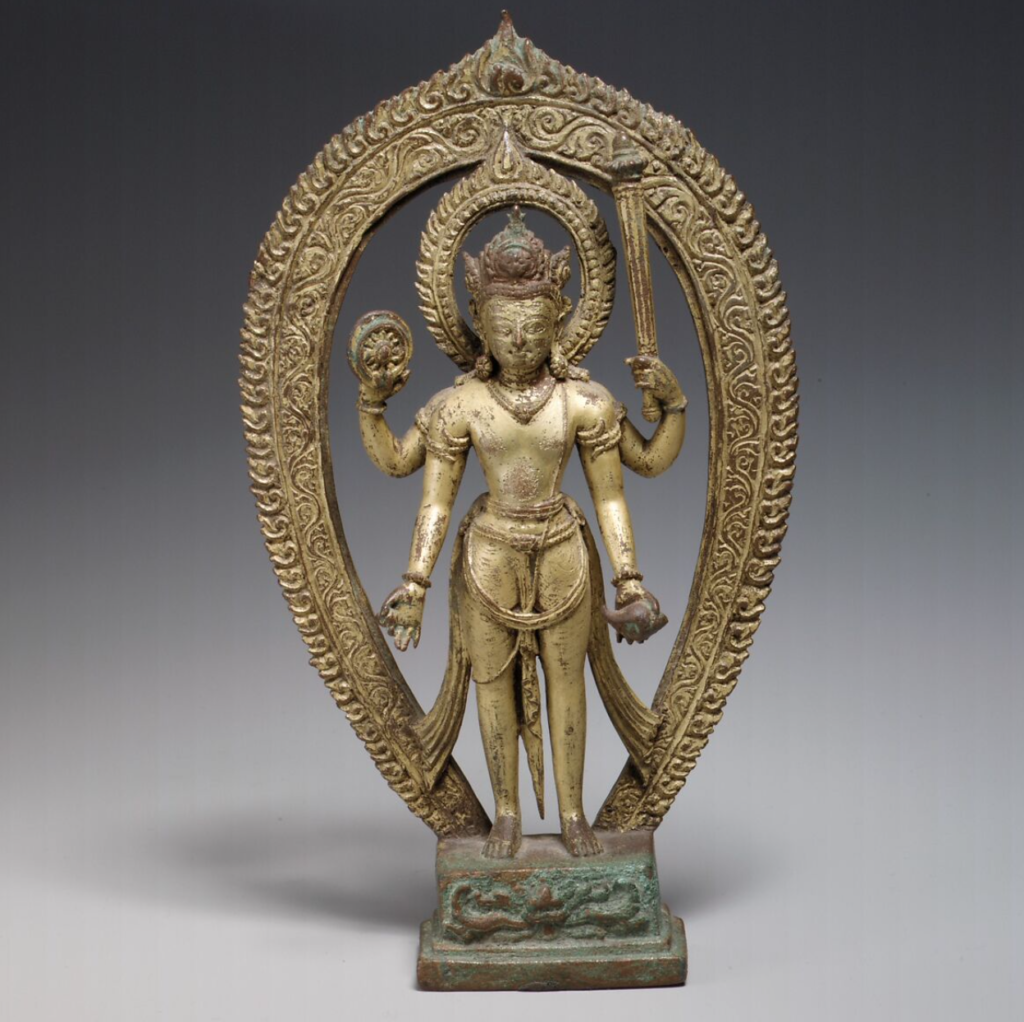Overview
The main goal and concept of my chapter is to show how in asian art they use sculptures as a source of religious inspiration for others to follow the path of enlightenment like the buddhas once did. I really enjoy sculpture art and when as a class we looked at and read about religious art in the Western Himalayas as it pertains to Buddhism I saw one of these sculptures which peaked my interest. I like history so I wanted to through my chapter look into the religious stories and reasons why and how these sculptures were made. The reason I chose these images first off was because these bodhisattva, buddhas, and other deities are some of the main ones in the religion. These myths over time gained the most traction and are one of the many different representations of these religious icons. I wanted to show a range of sculptures that have different purposes and connections from within the Buddhist religion whether that be the very famous Bodhisattva Maitreya or Durga. Every sculpture tells its own background story to inspire those who worship. Some terms that I felt were most important from me to define were Bodhisattva and buddha. Bodhisattva, is one of the most important term for my chapter and it means a person who is able to reach enlightenment but delays doing so out of compassion in order to save other beings. A Buddha is a person who has reached that final stage of enlightenment.
Additionally I chose to use these ones because they are made of gilt copper alloy which looks like gold as well as semi precious stones making them look very sacred and valuable. In Nepal, metal as a medium and sculpture making has been a popular within the region for centuries and these artisan metal workers are particularly valued often working in tandem with other artist from Tibet. I thought it would be interesting to dive into how they are able to make such intricate and detailed works with with such a rough medium like metal. There are two different ways that my reading talks about as the methods of constructing these sculptures. The first way is a very complex process called repoussé where an artisan hammers the back side of a thin sheet of metal which it indents on the outward side of it. The more popular method of creating sculptures like these is through what is called the lost wax technique. This version of sculpture making entails, “The sculptor shapes an image out of beeswax. Then layers of clay are applied to the wax model, from fine to coarse, creating a mold, usually in several parts. When the clay mold is heated, the clay hardens and the wax is drained out. The metalworker then pours molten metal into the empty space of the mold through the same channels the wax was poured out. When the metal has cooled and hardened, the clay mold is broken off, revealing the rough metal statue inside. This statue is often then polished, chiseled, combined with parts that were cast separately, gilded, inlaid with precious substances, and painted” (Rubin Museum). It is a truly fascinating process from where they start with just sheets of metal to a polished figure like the ones below.
The religious context of the sculptures comes from a later new form of Buddhism with an expanded pantheon and more elaborate rituals. Later Buddhism is what created the concept of Bodhisattvas and goddesses which is where all of my sculptures come from. The text cites that especially in Nepal and Tibet these sorts of sculptures of new deities were commonplace. Additional, ferocious deities like the version of Manjushri I have below (figure 3) were created signify protect Buddhism and its believers. It additionally talks about these sculptures serving as a visual aid for someone worshiping to these icons and the teachings that one can get from them.

The Bodhisattva Maitreya, the Buddha of the Future, Nepal, 11th century, Copper alloy with gilding and color, Met Museum, Accession Number: 1982.220.12
This is Bodhisattva Maitreya, the Buddha of the Future, whose prophecy is to achieve complete enlightenment and then return to earth to teach enlightenment or what is called the Dharma to others. This is probably the most famous bodhisattva and is sometimes hailed as the messiah. The intrinsic qualities that stand out to me in this example like all the others are the religious symbols. One hand is doing a symbolic buddhist gesture of Vitarka Mudra while on the other hand it is holding a flask that is supposed to be the elixir of life. Additionally, the text describes that the flask or Kamandula is Maitreya’s promise that she is returning to earth. It is astounding to me how detailed but sleek and minimal this version of Maitreya is with the upper part of the body holding an intricately designed crown and bejeweled arm pieces but in the lower portion smooth and minimalist detail besides the cloak. On the cloak there are details that almost resemble a lotus flower that are very faintly etched in. Lotus flowers in the Buddhist religion are important and mean self realization and enlightenment which Maitreya prophecy is to teach. You can see though that this figure is especially work as there are multiple dents and chips in the copper signifying wear that is synonymous with works from the 11th century.

Tara, the Buddhist Savior, 14th century, Nepal, Gilt copper alloy with color, inlaid with semiprecious stones, Met Museum, Accession Number: 66.179
This Figure is of Tara, The Buddhist Savior who in Tantric Buddhism is the supreme savior and goddess of mercy. There are many versions of Tara but this one is considered by the text to be Sitatara who the embodiment of perfected wisdom and the fulfiller of wishful boons. She gives this boons by way of the flower bud that is in the middle of her lower hand. The intrinsic qualities that stand out in this sculpture are that she as well is doing the symbolic buddhist gesture like Maitreya (figure #1). What differs for her is that of a fully bloomed lotus flower which symbolizes self realization. Additionally I would consider this sculpture to be maximalist versus figure #1 because she is bejeweled almost head to toe along with many lotus flowers on her pants.

The Bodhisattva Manjushri as a Ferocious Destroyer of Ignorance, 10th century, Nepal, Gilt-copper alloy with color and gold paint, Met Museum, Accession Number: 1982.220.13
The third sculpture is of the Bodhisattva Manjushri who the Met describes as the destroyer of ignorance and personifies correct knowledge. This angered version of Manjushri is rarely shown and as I said before were created in the later versions of Buddhism to cut through ignorance protecting Buddhism and its worshipers. The intrinsic qualities that stand out are the religious items and features that symbolize Manjushri like the sword which cuts through ignorance, the knotted hairstyle, and the tiger claw necklace. I really like this example in comparison to the other two because it shows a different perception of Bodhisattvas. This is seemingly less holy and more violent. Interestingly though like figure one and two there are details that are on the pants Manjushri that can be made out to be a lotus flower showing really how important that item is to Buddhism. This is also incredibly worn as some of the details on the figure cannot be seen as large quantities of the gold paint has withered and the gilt-copper alloy is showing.

Title: Vishnu, 10th–11th century, Nepal, Gilt-copper alloy, Met Museum, Accession Number: 1986.501.8
My fourth sculpture is of Vishnu who is the god of preservation and the divine protector and preserver of order. I picked vishnu specifically because its crossover from Buddhism into hinduism as Vishnu is one of the main gods in that religion. The key intrinsic details lie with what is in her four arms. In the upper two are a mace and a discus that is supposed to symbolize the earth goddess. In the lower hands is a conch shell which is used as a tool in Buddhist ritual. The other hand is doing the symbolic buddhist gesture like many of my other sculptures are doing of Vitarka Mudra. Interestingly enough the tripartite crown in the sculpture with what is supposed to be a lions face has roots from northern India. I picked this version of Vishnu also because I really enjoy the intricately detailed arch that sits directly behind the main figure. What is also interesting is the plinth that Vishnu is standing on as there is some unknown inscriptions or art on in which makes it fascinating. She is considered the sister of Durga, who is my last sculpture.

Durga as Slayer of the Buffalo Demon Mahishasura, 14th–15th century, Nepal, Gilt copper alloy, inlaid with semiprecious stones, Met Museum, Accession Number: 1986.498
My last sculpture is of Durga who is the slayer of the buffalo demon Mahishasura. The 18 hands on Durga is meant to symbolize the immense power she has to combat evil forces. She is considered one of if not the most powerful deity in Buddhism and hinduism. I picked Durga also for the legend that is told about her. Mahishasura was a seemingly invincible demon that could not be stopped by other deities like Vishnu who then created Durga. Durga then effortlessly slayed the demon Mahishasura saving the heavens and the world. A festival in India called Durga Puji was created to celebrate this triumph annually. Usually she is holding many types of weapons like swords, shields, axes, etc but in this sculpture she is holding what looks like only five items. Other qualities that stand out in this sculpture are the many semiprecious stones that are all over her crown and body. It really signifies the status that Durga holds within the religion. She is also positions in a way that makes her look very powerful too with a really athletic stance and the many arms held in the air seems almost to intimidate.
Reading List
“Art Making.” Project Himalayan Art. Accessed May 11, 2023. https://projecthimalayanart.rubinmuseum.org/themes/art-making/.
“The Bodhisattva Maitreya, the Buddha of the Future: Nepal: Thakuri Period.” The Metropolitan Museum of Art. Accessed May 11, 2023. https://www.metmuseum.org/art/collection/search/38328?deptids=6&%3Bwhere=Nepal&%3Bhigh=on&%3Bft=%2A&%3Boffset=0&%3Brpp=40&%3Bpos=15.
Dehejia, Vidya. “Buddhism and Buddhist Art: Essay: The Metropolitan Museum of Art: Heilbrunn Timeline of Art History.” The Met’s Heilbrunn Timeline of Art History, January 1, 2001. https://www.metmuseum.org/toah/hd/budd/hd_budd.htm.
“Durga as Slayer of the Buffalo Demon Mahishasura: Nepal.” The Metropolitan Museum of Art. Accessed May 11, 2023. https://www.metmuseum.org/art/collection/search/38341?deptids=6&%3Bwhere=Nepal&%3Bhigh=on&%3Bft=%2A&%3Boffset=0&%3Brpp=40&%3Bpos=1.
“Durga.” Encyclopædia Britannica. Accessed May 11, 2023. https://www.britannica.com/topic/Durga#:~:text=Durga%2C%20(Sanskrit%3A%20“the,otherwise%20powerless%20to%20overcome%20him.
“Maitreya.” Encyclopædia Britannica, March 16, 2023. https://www.britannica.com/topic/Maitreya-Buddhism.
“The Bodhisattva Manjushri as a Ferocious Destroyer of Ignorance: Nepal.” The Metropolitan Museum of Art. Accessed May 11, 2023. https://www.metmuseum.org/art/collection/search/38330?deptids=6&where=Nepal&high=on&ft=*&offset=0&rpp=40&pos=4
Menon, Arathi. “Durga Slays the Buffalo Demon at Mamallapuram.” Khan Academy . Accessed May 11, 2023. https://www.khanacademy.org/humanities/art-asia/south-asia/x97ec695a:500-1100-c-e-deccan-and-south/a/durga-slays-the-buffalo-demon-at-mamallapuram.
“Tara, the Buddhist Savior: Nepal (Kathmandu Valley): Malla Period.” The Metropolitan Museum of Art. Accessed May 11, 2023. https://www.metmuseum.org/art/collection/search/50799?deptids=6&%3Bwhere=Nepal&%3Bhigh=on&%3Bft=%2A&%3Boffset=0&%3Brpp=40&%3Bpos=5.
“Vishnu: Nepal (Kathmandu Valley): Thakuri Period.” The Metropolitan Museum of Art. Accessed May 11, 2023. https://www.metmuseum.org/art/collection/search/38326?deptids=6&%3Bwhere=Nepal&%3Bhigh=on&%3Bft=%2A&%3Boffset=0&%3Brpp=40&%3Bpos=16.